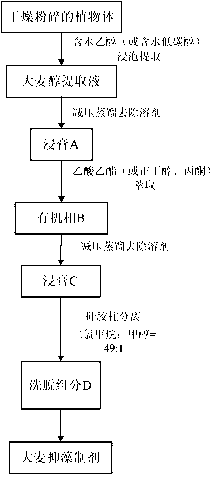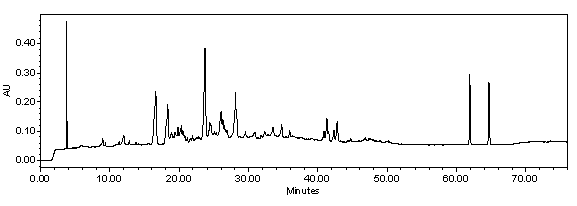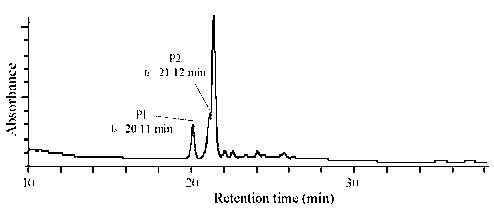Method for extracting allelopathy refinement component having algae inhibition activity from barley by using ethyl acetate
A technology of algae-inhibiting activity and ethyl acetate, applied in botany equipment and methods, chemicals for biological control, applications, etc. Unable to inhibit the growth of algae and other problems, achieve the effect of good algae inhibition, low price, and good ecological security
- Summary
- Abstract
- Description
- Claims
- Application Information
AI Technical Summary
Problems solved by technology
Method used
Image
Examples
Embodiment 1
[0025] Firstly, the barley straw was dried at 50° C. for 96 hours, and the dried barley was crushed to 20 meshes. Soak 400 g of dry barley with 2 L of aqueous ethanol with an alcohol content of 75%, extract 5 times at 20 °C for 2 hours each time, and combine to obtain barley alcohol extract; In the rotary evaporator, the solvent is distilled off under reduced pressure to obtain extract A; the extract A is extracted twice with 1-1.5 times of ethyl acetate with a volume of water successively, and extract B is obtained after concentrating the ethyl acetate phase extract. The HPLC spectrum of ointment B sees figure 2 ;
[0026] Secondly, the extract B was subjected to silica gel column chromatography, and the eluents were dichloromethane and methanol, and the volume ratios were 100:0, 49:1, 19:1, 10:1, 3:2, 4:1 and The gradient of 0:100 was eluted, the eluent was collected and the solvent was removed, and the anti-algae activity of each eluted component was tested. The results ...
Embodiment 2
[0031] Firstly, the barley straw was dried at 70° C. for 48 hours, and the dried barley was crushed to 50 mesh. Soak 1 Kg of dry barley with 4.5 L of ethanol containing 40% alcohol, extract 2 times at 80°C for 6 hours each time, and combine to obtain the barley alcohol extract; put the barley alcohol extract at 50°C under reduced pressure in a rotary evaporator to remove the solvent to obtain extract A; sequentially extract extract A with an appropriate amount of ethyl acetate four times, and concentrate the ethyl acetate phase extract to obtain extract B;
[0032] Secondly, the extract B was subjected to silica gel column chromatography, and the eluent was dichloromethane: methanol with a gradient of 100:0, 49:1, 19:1, 10:1, 3:2 to 0:100. The eluate was collected respectively and the solvent was removed, and the algae-inhibiting activity was tested for each eluted component, and the results are shown in Table 2:
[0033] eluent component ratio Algae inhibition ...
PUM
 Login to View More
Login to View More Abstract
Description
Claims
Application Information
 Login to View More
Login to View More - R&D
- Intellectual Property
- Life Sciences
- Materials
- Tech Scout
- Unparalleled Data Quality
- Higher Quality Content
- 60% Fewer Hallucinations
Browse by: Latest US Patents, China's latest patents, Technical Efficacy Thesaurus, Application Domain, Technology Topic, Popular Technical Reports.
© 2025 PatSnap. All rights reserved.Legal|Privacy policy|Modern Slavery Act Transparency Statement|Sitemap|About US| Contact US: help@patsnap.com



